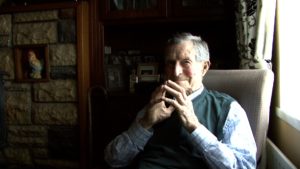 Jack Lynch writes about the late Paddy Lowry (1919 – 2013).
Jack Lynch writes about the late Paddy Lowry (1919 – 2013).
It was with great sadness that we heard of the recent passing of our honoured Tradition Bearer, Paddy Lowry. Paddy, from Forlaka, near Kinnitty, was one of the tellers featured in Nuala Hayes’ 2002 DVD Tales at the Crossroads. This was one of the documentaries that resulted from Nuala’s folklore-collecting project commissioned by the Arts Office of Portlaoise. The Slieve Bloom Mountains – a hidden fastness of beauty that nestles between the counties of Laois and Offaly – proved home to a remarkable number of residents who had a dedicated engagement with the lore and landscape of their native area. Nuala’s researches and listening talents introduced us to venerable, gentle and good humoured elders who had cherished the lore of their native environs. This is a landscape which revealed to them memory traces from prehistoric times to the present day. The old tales tell us that it was to the Slieve Blooms that Fionn mac Cumhaill’s mother sent him, on the death of his father, to be trained in the skills of survival by two wise women. Paddy’s friend and neighbour, Paddy Heaney (also an SoI Tradition Bearer) can point to a hillside field where, during the reign of Elizabeth 1, the army of the Gaelic Earl Hugh O’Neill stopped to wait for the army of Red Hugh O’Donnell on their winter march of 300 hundred miles from Ulster in an attempt to relieve the Spanish force at Kinsale. The local appearance of an army of more than six thousand men was bound to imprint itself on the lore of the neighbourhood.
While Kinsale was the ultimate battle in England’s conquest of Gaelic Ireland and led to the Flight of the Earls, many of the retreating stragglers found safe refuge back in the Slieve Blooms – hence, to this day, the occurrence of many Northern names – Maguires and McCanns – in the area.
I’m reminded of the American folklorist Henry Glassie’s intrigued accounts of his time spent in Co. Fermanagh in the 1970’s, when a local farmer he had befriended points out that the field the pair of them had just crossed was ‘The Red Meadow’, so named because it bordered on the bloody bank of the river that was the site of the Battle of the Ford of the Biscuits in 1594. Glassie writes something that for me sums up the importance of the Slieve Bloom men we came to know as ‘the two Paddies.’
“The local historian’s tales fly as sounds out of the dark; they hit the ear, and stick in the mind or vanish. Compared with historical narratives preserved in ink, they are less accurate in some details, more accurate in others. Their authors overturn the norms of historians in other traditions and connect to an ancient and vital Irish idea by ordering history more in space than in time. The local historians may be vague or inaccurate about dates, but they are impeccably precise about locations. Their history is set first in place. It is present, tangible. But they do not neglect time. They are right about sequences, and especially as events approach the present, the local historian’s accounts are fuller and more complex than the written record.” from Irish Folk History (my italics).
In Tales at the Crossroads Paddy Lowry invites us into his landscape and in easy, twinkling conversation reveals the wealth of local tradition. Drawn to the old art of dowsing since his 30’s, he explains the water-divining power of the hazel switches and converses about Druid lore, ley lines and the local belief in ‘Fairy Passes’. Here was an unassuming local genius, a gentle scholar and a mine of the lore of the people.
Another valuable outcome of Nuala’s adventure was the setting up of the Slieve Bloom Storytelling Festival, steered from the start by Kinnitty woman Christina Byrne. This festival (now in its eleventh year) has brought the wisdom of people like Paddy to the schoolchildren of the area and has also brought a succession of storytellers from far afield to be entranced by the Slieve Blooms and its people. Paddy, a retired farmer, had recently published a memoir of his life in the foothills of those mountains. His final public performance was probably at last October’s festival. It was a joy to meet him again on that occasion. In conversation he recounted to me of meeting in his youth with a neighbouring woman who had survived the Famine with stories to tell. He passed away peacefully on March the 16th. All who had the pleasure of his acquaintance will morn the passing of his noble spirit.
Ar dheis Dé go raibh a anam dílis